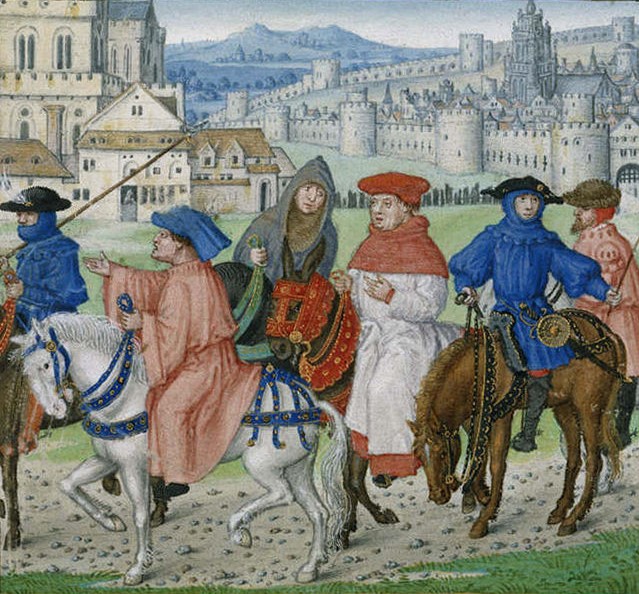The Canterbury Tales was written in Middle English by Geoffrey Chaucer, who started writing it in 1387. The work has the structure of a frame narrative story, the pilgrimage of about thirty people going from London to the shrine of Thomas Beckett in Canterbury Cathedral. The work is structured in three parts: a general prologue, the prologues to the tales and 24 tales.
Destinatari: 3° anno di liceo.
The Hundred Years’ War
1327– Edward III claimed the crown of France, because the French King was his uncle, on his mother’s side, but also for the English commercial interests in Flanders, threatened by France. The Hundred Years’ War began.
1348– The war was interrupted by the Black Death, which killed a third of the population. The labour shortage led to a quick rise of food prices and wages of agricultural labourers.
During the last years of Edward III’s reign the religious reform movement of the Lollards, led by the scholar John Wycliffe, started to criticise the corruption in monastic orders and promoted a life of evangelical poverty.
1377– Richard II succeeded his grandfather Edward III.
1381– Richard II imposed the poll tax, a tax on every adult regardless of income, due to the costs of the long war against France. The heavy taxes provoked the rebellion of the lower classes, the so called Paesants’ Revolt: a crowd of people marched on London and killed the Archbishop of Canterbury and the King’s Treasurer. Richard II made some promises he never kept and the rebellion was quickly put down.
1399– Richard II had become a despotic king and was forced to abdicate. On 13th October, Henry Bolingbroke, Earl of Derby and Duke of Hereford, was crowned king with the name of Henry IV. Henry Bolingbroke usurped the throne from Edmund Mortimer, fifth Earl of March, aged seven, who preceded him in succession law. This usurpation led to the War of the Two Roses about fifty years later.
Geoffrey Chaucer was born in London around 1340. He belonged to the middle class, his father was a wine merchant. At that time, Latin was the language of commerce, so he was sent to a Grammar school. He received an excellent education and he was also interested in medicine, astronomy, law and alchemy. He translated works from Latin, French and Italian into English.
He was closely connected to the royal court thanks to John of Gaunt, who was his benefactor, and his marriage with Philippa, a lady-in-waiting to Queen so he had important positions: Justice of the Peace in Kent and Clerk of the King’s Works. In 1386 he became a Member of Parliament.
In 1387, after his wife’s death, he started writing The Canterbury Tales. In the last decade of his life, Chaucer had financial problems.
He died in 1400 and was buried in Westminster Abbey, and you can visit his tomb in Poets’ Corner, the section of the South Transept of the Abbey.
Frame
The General Prologue presents the narrative frame of this unfinished work. The narrator joins a group of 29 people, who belong to different social classes. They all meet at the Tabard Inn in London in springtime to go on a pilgrimage to Thomas Becket’s shrine in Canterbury.
The narrator presents the pilgrims describing each of them in detail.
The host of the inn proposes the tale-telling competition as a way of passing the time on the long journey. Every pilgrim will tell two stories on the way to Canterbury and two coming back. The pilgrim who tells the best story will have a free meal at the tavern upon his return, paid by the other pilgrims.
The pilgrims accept and the host joins the company.
Themes
The main theme is the journey: it is set in spring because it is connected to the idea of rebirth.
The Tabard Inn in London represents conviviality and pleasure and Canterbury, never reached because the work remained unfinished, is a symbol of spirituality.
Through the tales, Chaucer cover a a wide range of themes: the courtly love, the marriage, the corruption of the Church, hypocrisy and chivalry.
Style
The Canterbury Tales is a long poem, only two tales are written in prose, written in heroic rhyming couplets (AABB). Every line is a iambic pentameter: 5 feet (every foot is a couple of syllables) following the stress pattern: unstressed/stressed.
Here is an example from The Knight in the General Prologue:
There was | a Knight, |a most | disting | uished man,
Who from | the day | on which | he first | began
The syllables in bold are stressed.
Language
Chaucer is considered the father of English literature. He used what we call Middle English, probably generated by a mixture of French and Anglo-Saxon, and very similar to Modern English.
The pilgrims come from different social classes that reflect both the fading feudal order and the emerging urban social classes made by many professions and small class distinctions.
Chaucer intended to give a portrait of contemporary society, but the pilgrims are not stereotyped. They are individuals masterly described by the author with realistic details and psychological characterisation.
In the General Prologue many of the pilgrims are portrayed physically, and a detailed description of their appearance, clothes and accessories, illustrate their character and social status. We also learn about their qualities and weaknesses through ironic but discreet comments of the narrator.
The list that follows is complete and ordered in the way they are presented in the General Prologue.
- The Knight
- The Squire
- The Yeoman
- The Prioress
- The Monk
- The Friar
- The Merchant
- The Clerk
- The Sergeant of the Law
- The Franklin
- The Skilled Tradesmen (a Haberdasher, a Carpenter, a Webber, a Dyer and a Tapiser)
- The Cook
- The Shipman
- The Doctor of Physic
- The Wife of Bath
- The Parson
- The Ploughman
- The Miller
- The Manciple
- The Reeve
- The Summoner
- The Pardoner

